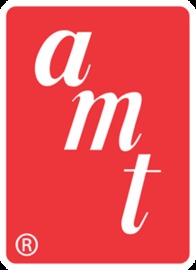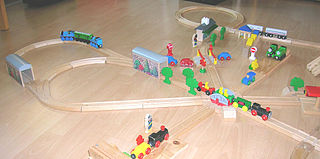
Movable type is the system and technology of printing and typography that uses movable components to reproduce the elements of a document usually on the medium of paper.

A model car, or toy car, is a miniature representation of an automobile. Other miniature motor vehicles, such as trucks, buses, or even ATVs, etc. are often included in this general category. Because many miniature vehicles were originally aimed at children as playthings, there is no precise difference between a model car and a toy car, yet the word 'model' implies either assembly required or the accurate rendering of an actual vehicle at smaller scale. The kit building hobby became popular through the 1950s, while the collecting of miniatures by adults started to pick up momentum around 1970. Precision-detailed miniatures made specifically for adults are a significant part of the market since the mid-1980s.

A scale model is a physical model which is geometrically similar to an object. Scale models are generally smaller than large prototypes such as vehicles, buildings, or people; but may be larger than small prototypes such as anatomical structures or subatomic particles. Models built to the same scale as the prototype are called mockups.

Lionel, LLC is an American designer and importer of toy trains and model railroads that is headquartered in Concord, North Carolina. Its roots lie in the 1969 purchase of the Lionel product line from the Lionel Corporation by cereal conglomerate General Mills and subsequent purchase in 1986 by businessman Richard P. Kughn forming Lionel Trains, Inc. in 1986. The Martin Davis Investment Group (Wellspring) bought Lionel Trains, Inc. in 1995 and renamed it Lionel, LLC.

Joshua Lionel Cowen was an American electrical engineer and inventor. Cowen attended two different colleges but never obtained a degree. He had a mechanical inclination and was interested in the principals of electricity. He worked a lot with batteries, transformers, and electrical motors which led to inventions and innovations. His first patented invention for a photographer's flash igniter for flash photography developed into a detonator for exploding mines for the United States Navy. That resulted in a $12,000 defense contract which gave him the money to go into the novelty business.

O scale is a scale commonly used for toy trains and rail transport modelling. Introduced by German toy manufacturer Märklin around 1900, by the 1930s three-rail alternating current O gauge was the most common model railroad scale in the United States and remained so until the early 1960s. In Europe, its popularity declined before World War II due to the introduction of smaller scales.

Louis Marx and Company was an American toy manufacturer in business from 1919 to 1980. They made many types of toys including tin toys, toy soldiers, toy guns, action figures, dolls, toy cars and model trains. Some of their notable toys are Rock'em Sock'em Robots, Big Wheel tricycles, Disney branded dollhouses and playsets based on TV shows like Gunsmoke. Its products were often imprinted with the slogan "One of the many Marx toys, have you all of them?"

American Flyer is a brand of toy train and model railroad manufactured in the United States.
The Ives Manufacturing Company, an American toy manufacturer from 1868 to 1932, was the largest manufacturer of toy trains in the United States from 1910 until 1924, when Lionel Corporation overtook it in sales.
Bassett-Lowke was an English toy manufacturing company based in Northampton. Founded by Wenman Joseph Bassett-Lowke in 1898 or 1899, that specialized in model railways, boats and ships, and construction sets. Bassett-Lowke started as a mail-order business, although it designed and manufactured some items.

Bing or Gebrüder Bing was a German toy company founded in 1863 in Nuremberg, Germany by two brothers, Ignaz Bing and Adolf Bing, originally producing metal kitchen utensils, but best remembered for its extensive lines of model trains and live steam engines.
MTH Electric Trains is an American toy train and model railroad designer, importer, and manufacturer. A privately held company based in Columbia, Maryland, MTH was formerly known as Mike's Train House.

Lionel Corporation was an American toy manufacturer and holding company of retailers that had been in business for over 120 years. It was founded as an electrical novelties company. Lionel specialized in various products throughout its existence. Toy trains and model railroads were its main claim to fame. Lionel trains have been produced since 1900, and their trains drew admiration from model railroaders around the world for the solidity of their construction and the authenticity of their detail. During its peak years in the 1950s, the company sold $25 million worth of trains per year. In 2006, Lionel's electric train became the first electric toy inducted into the National Toy Hall of Fame. In 1969, they sold their model train lines to General Mills, but continued to operate until 1993 as a holding company for their toy stores. Its model trains are still in production as a separate company.
The history of Lego began in 1932, when Ole Kirk Christiansen founded the company in a Danish carpentry workshop, and continues into the 21st century as a popular and very profitable line of construction toys and related products and services, with a significant impact on various areas of popular culture. Despite its expansion, the company remains privately held.

Aluminum Model Toys (AMT) is a toy manufacturing brand founded in Troy, Michigan in 1948 by West Gallogly Sr. AMT became known for manufacturing 1/25 scale plastic automobile dealer promotional model cars and friction motor models, and pioneered the annual 3-in-1 model kit buildable in stock, custom, or hot-rod versions. The company made a two-way deal in 1966 with Desilu Productions to produce a line of Star Trek models and to produce a 3/4 scale exterior and interior filming set of the Galileo shuttlecraft. It was also known for producing model trucks and movie and TV vehicles.

Merchandise for the Thomas & Friends franchise has been produced to capitalize on the success of the television series Thomas & Friends. Whilst merchandise was produced alongside due to the popularity of the first of The Railway Series by the Rev. W. Awdry since 1945, and the original broadcast of the television series in 1984 in the United Kingdom, large numbers of manufacturers have sought to produce Thomas-branded items after the television series was broadcast in the United States and Japan.

Wooden toy trains are toy trains that run on a wooden track system with grooves to guide the wheels of the rolling stock. While the trains, tracks and scenery accessories are made mainly of wood, the engines and cars connect to each other using metal hooks or small magnets, and some use plastic wheels mounted on metal axles. Some trains are made to resemble anthropomorphical, fictional, and prototypical railroad equipment.

The history of printing starts as early as 3500 BCE, when the proto-Elamite and Sumerian civilizations used cylinder seals to certify documents written in clay. Other early forms include block seals, hammered coinage, pottery imprints, and cloth printing. Initially a method of printing patterns on cloth such as silk, woodblock printing for texts on paper originated in China by the 7th century during the Tang dynasty, leading to the spread of book production and woodblock printing in other parts of Asia such as Korea and Japan. The Chinese Buddhist Diamond Sutra, printed by woodblock on 11 May 868, is the earliest known printed book with a precise publishing date. Movable type was invented by Chinese artisan Bi Sheng in the 11th century during the Song dynasty, but it received limited use compared to woodblock printing. Nevertheless, the technology spread outside China, as the oldest printed book using metal movable type was the Jikji, printed in Korea in 1377 during the Goryeo era.

Paper models, also called card models or papercraft, are models constructed mainly from sheets of heavy paper, paperboard, card stock, or foam.
The Barclay Manufacturing Company was an American metal toy company based in New Jersey that specialised in diecast toy cars and hollowcast toy soldiers. Due to their common availability at five and dime stores, collectors often refer to Barclay's toy soldiers as "Dimestore soldiers".














